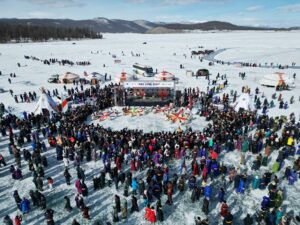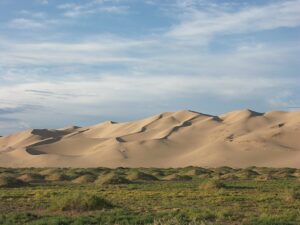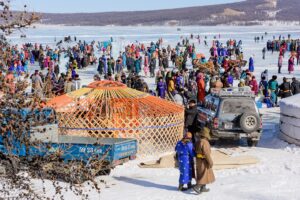Mongolia is known for its wide-open spaces and grandiose landscapes, it is also a country rich in tradition and culture, and history which reveals its beliefs to us through important monasteries. Geru Journey presents you with the top 10 monasteries of Mongolia that you may want to visit during your travel in the land of the blue sky.
- Choijin Lama Monastery
The Choijin Lama Monastery was built around 1904 to 1908, dedicated to the little brother of Bogd Khan, Choijin Lama Luvsankhaidav.
Choijin Lama temple was nearly destroyed by communists in 1938 but luckily saved in 1942 to be used as a museum demonstrating the ‘feudal’ ways of the past.
Mongolians recommenced their religious freedom in 1990, but a monastery is no longer an active place of worship and still working as a museum. Today, the Choijin Lama Temple works as a museum with its four temples and four arch doors and houses hundreds of religious and art collections dating back from the 17th, 18th, 19th, and 20th centuries.
Entry fee: 8500 MNT
Working hours: 10:00 AM to 6 PM
- Gandantegchinlen Monastery
Mongolia’s most important religious center and one of its biggest tourist attractions the Gandan Tegchilen monastery is located in the center of Ulaanbaatar city. The Gandantegchinlen monastery was built in 1813 and is known for the 26.5m tall golden statue of Migjid Janraisag. The monastery had more than 100 temples and monasteries that served a population of about 50,000 in Mongolian Capital Ikh Khuree at the beginning of the 19th century. A lot of part of the monastery was destroyed in the religious purges of communists in 1937. From the early 1990s that the people of Mongolia started to openly practice Buddhism again and the Gandan Tegchilen monastery has become the biggest Buddiht Monastery once again.
Nowadays, hundreds of monks live there and study Buddhism.
Entry fee: 7000 MNT
Video: 10000 MNT
Open from 8:00 AM to 6 PM (Most chapels are closed in the afternoon)
- Erdene Zuu monastery
Located in Kharkhorin city, 380 km away from Ulaanbaatar, Erdene Zuu, the oldest surviving Buddhist monastery in Mongolia was established in the 16th century. The Erdene Zuu monastery was built on ruins of ancient Kharkhorin city, so you still can see some remains from the 13th century. Now the Monastery practice Buddhism and also works as a museum.
Entry fee: 8000 MNT
Open from 9:00 AM to 6 PM (Most chapels are closed in the afternoon)
- Amarbaysgalant monastery
Amarbayasgalant Monastery complex is located in Selenge province, roughly around 500km from Ulaanbaatar city. The Monastery was built during 1727-1736, for the honor of Saint Zanabazar, the first Bogd the Mongolian Buddhist leader and artist, founder of the Mongol School of religious art.
The Amarbaysgalant monastery was once the biggest monastery in Mongolia with over 40 chapels, and temples surrounded by long walls. However, after the religious purge in 1938, only 28 temples have remained and stayed under State protection since 1944.
Entry fee: 5000 MNT
Open from 9:00 AM to 6 PM (Most chapels are closed in the afternoon).
- Ariyapala meditation temple
Aryapala meditation temple is located in Gorkhi Terelj National park, only 2 km from the iconic Turtle rock, and it was built in 2006.
The Ariyapala meditation temple is built on the hillside of a mountain covered with larches and granite rock, which is now famous for being the viewpoint of the Terelj national park. Anyone who is visiting the temple can meditate, hike around or just enjoy the scenery and take a photo.
Entry fee: 2000 MNT
Open from 9:00 AM to 6 PM (Most chapels are closed in the afternoon)
- Khamar monastery
Khamar monastery was built around the 1820s in Dorno Gobi province, by famous educator and poet Danzanravjaa. 200 years old monastery is now famous for being world energy center as people visit there to receive good energy.
The Khamar monastery is surrounded by the Gobi desert but you still can see cherry trees blooming in spring. Also, there is breast rock, the mountain that you can make a wish for, 108 meditation stupa caves, etc, that make your visit unique.
Entry fee: 2000 MNT
Open from 9:00 AM to 6 PM
- Tuwkhun monastery
The Tuwkhun monastery is located in the boundary of Arkhangai and Uvurkhangai provinces on the peak of the Undur-Shireet mountain with 2312 meters above sea level. The Tuwkhun monastery was established by Siant Zanabazar the first Bogd in Mongolia in the 16th century. Founder of the monastery, Saint Zanabazar created his famous script “Soyombo” there in 1680. The Tuwkhun monastery has been in state protection since 1998 and as “The most wonderful valuable object” was registered by UNESCO in the category of cultural heritage.
Entry fee: 5000 MNT
Open from 9:00 AM to 6 PM
Travel tip: You can ride a horse up to the temple from the parking lot.
- Ongi monastery
Located in Middle Gobi, the Ongi Temple ruins is where a thousand lamas had lived a hundred years ago. Located in Ongi river bank Ongi monastery was twin, and separated by Ongi river, and connected with a wooden bridge. Ongi monastery was the biggest Buddhist monastery in the Mongolian Gobi region but was sadly destroyed by the communists during religious purge repression in the 1930s. Through this dark time, all of the monasteries were destroyed and over 17,000 monks were killed or arrested and never seen again, with total victims can be counted of about 27,000 people. This dark history of violence at Ongiin monastery is still visible in bare eyes, even though it happened over 80 years ago.
To this day, the only working chapel was rebuilt in the 1990s. Also, at the entrance, You can visit the small ger museum that shows the history of the Ongi monastery.
Entry fee: 3000 MNT
Museum: 2000 MNT
Open from 9:00 AM to 6 PM
- Baldan Bereewen monastery
The lovely Baldan Bereeven Monastery is a Khentii Province. The very first temple of the monastery was set up in 1654 and developed to be perhaps the greatest religious community in Mongolia during the nineteenth century. Monastery used to house up to 8000 priests until the 1930s, religious purge by communists destroy it.
At the point when the democracy came in the 1990s in Mongolia, more elder monks who were removed, and run away from Baldan Bereevan as young pupils during the 1930s got back to the religious community and reestablished a couple of the primary sanctuaries of the monastery. Presently the Baldan Bereewen religious community is recorded as a Cultural Heritage in UNESCO.
Entry fee: 2000 MNT
Open from 9:00 AM to 6 PM
- Shankh Monastery
Shankh Monastery, ”Shankh Khiid”, is located in the province of Uvurkhangai province, southeast of Kharkhorin city. The monastery was established in 16478 same time as the Tuwkhun monastery and the founder was Saint Zanabazar the first Bogd of Mongolia. The monastery belongs to the Yellow Hat Sect, “Gelugpa”, which is a school of Tibetan Buddhism.
Entry fee: 5000 MNT
Open from 9:00 AM to 6 PM





